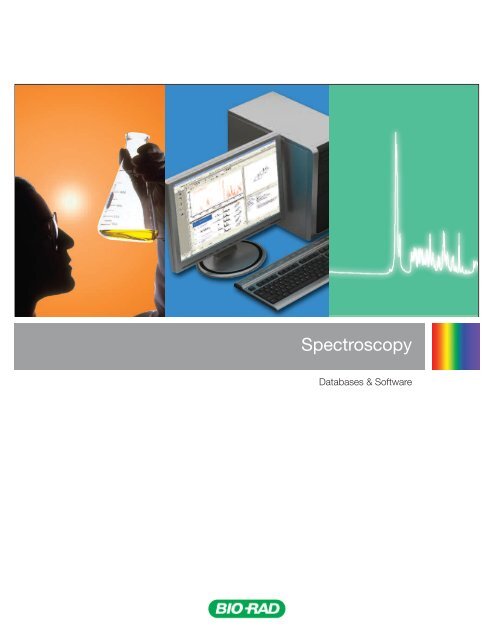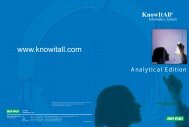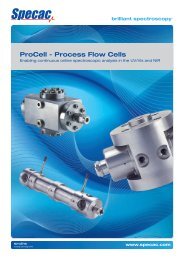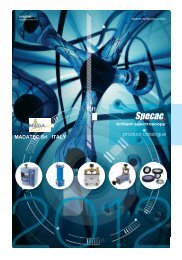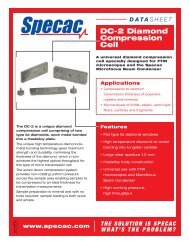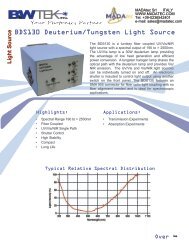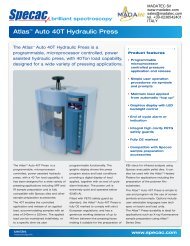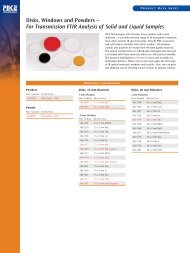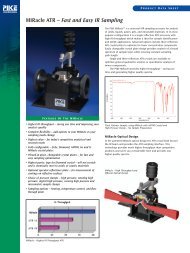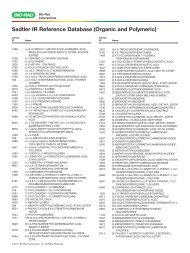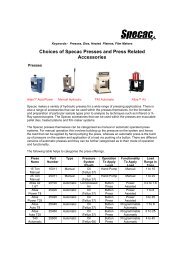Spectroscopy - Madatec
Spectroscopy - Madatec
Spectroscopy - Madatec
You also want an ePaper? Increase the reach of your titles
YUMPU automatically turns print PDFs into web optimized ePapers that Google loves.
<strong>Spectroscopy</strong><br />
Databases & Software
Table of Contents<br />
Databases & Software for <strong>Spectroscopy</strong>.................................................................................. 1<br />
Spectral Databases..................................................................................................................... 2<br />
IR Databases: Polymers and Related Compounds....................................................................................................................................................2<br />
Acrylates & Methacrylates<br />
Hummel Industrial Polymers, v.1-3<br />
Adhesives & Sealants<br />
Hummel Industrial Polymers, v.1<br />
Adhesives & Sealants (Subset A)<br />
Hummel Industrial Polymers, v.2<br />
ATR of Basic Polymers<br />
Hummel Industrial Polymers, v.3<br />
ATR of Polymers<br />
Hummel/Sadtler Polymers<br />
Basic Monomers & Polymers v.1 (Unmodified)<br />
Monomers & Polymers (Comprehensive)<br />
Basic Monomers & Polymers v.2 (Unmodified)<br />
Monomers & Polymers v.1 (Modified)<br />
Coating Chemicals<br />
Monomers & Polymers v.2 (Modified)<br />
Controlled Pyrolyzates of Polymers<br />
Plasticizers<br />
Electric Power Plant Materials<br />
Polymer Additives<br />
Epoxy Resins, Curing Agents, & Additives<br />
Polymeric Compounds<br />
Flame Retardants<br />
Protective Materials<br />
Hummel Defined Polymers<br />
Rubber Chemicals<br />
Hummel Defined Polymers, Basic Collection<br />
Sadtler/Scholl Polymer Processing Chemicals<br />
IR Databases: Pure Organic Compounds........................................................................................................................................................................4<br />
Alcohols and Phenols<br />
Nucleic Acids, Nucleosides, & Nucleotides<br />
Aldehydes<br />
Organometallics, Inorganics, Silanes, Boranes, & Deuterium Compounds<br />
Amino Acids & Peptides<br />
Phosphorus Compounds<br />
Anhydrides & Lactones<br />
Q-Sadtler Reference Database<br />
Carboxylic Acids<br />
Selected IR Reference Database<br />
Condensed Phase IR Standards (Comprehensive)<br />
Select Standards<br />
Dyes, Alkynes, & Azo Compounds<br />
Select Vapor Phase<br />
Esters<br />
Solvents (Unblended)<br />
Explosive Materials<br />
Solvents by ATR<br />
Gases & Vapors<br />
Solvents by Vapor Phase<br />
Hydrocarbons<br />
Starter Databases<br />
Hydrocarbons & Halogenated Hydrocarbons<br />
Steroids Database<br />
Industrial Chemicals, FT-IR Pure Organic Compounds Sugars & Carbohydrates<br />
Industrial Chemicals, FT-IR Basic Organic Compounds Sulfur Compounds<br />
Intermediates (Unblended)<br />
University Standards<br />
Ketones<br />
Merck/Sadtler<br />
Vapor Phase IR Standards (Comprehensive)<br />
IR Databases: Industrial Compounds................................................................................................................................................................................7<br />
Basic Surfactants (Unmodified)<br />
Petroleum Chemicals<br />
Fats, Waxes, & Derivatives<br />
Polyols<br />
Hummel Surfactants<br />
Solvents (Industrial Quality)<br />
Intermediates (Industrial Quality)<br />
Surfactants (Comprehensive)<br />
Lubricants<br />
Surfactants v.1 (Modified)<br />
Lubricant Additives<br />
Surfactants v.2 (Modified)<br />
IR Databases: Forensic Sciences........................................................................................................................................................................................8<br />
ATR of Controlled & Prescription Drugs<br />
Flavors, Fragrances, & Oils<br />
ATR of Steroids, Androgens, Progestins, & Estrogens Flavors & Fragrances (IR Vapor Phase)<br />
Automobile Paint Chips<br />
Food Additives<br />
Biochemicals<br />
Georgia State Crime Lab<br />
Canadian Forensics<br />
Pharmaceutical Excipients<br />
Commonly Abused Drugs (Acid/Base)<br />
Pharmaceuticals<br />
Dyes<br />
Prepared & Prescription Drugs (Acid/Base)<br />
Dyes, Pigments, & Stains<br />
Steroids<br />
Fibers & Textile Chemicals<br />
Fibers by Microscope<br />
Steroids, Androgens, Progestins, & Estrogens<br />
IR Databases: Environmental Applications ..................................................................................................................................................................10<br />
HAZMAT Database<br />
Priority Pollutants<br />
Pesticides & Agricultural Chemicals<br />
Sadtler EPA Vapor Phase<br />
Pollutants (IR Vapor Phase)<br />
Water Treatment Chemicals
HaveItAll ® Annual License for Databases................................................................................... 13<br />
KnowItAll IR/NIR Edition<br />
KnowItAll <strong>Spectroscopy</strong> Edition<br />
KnowItAll Analytical Edition<br />
SearchIt TM<br />
Spectral Mixture Analysis<br />
Overlap Density Heatmaps<br />
DrawIt TM<br />
ReportIt TM<br />
Database Building Option<br />
AnalyzeIt TM IR<br />
AnalyzeIt Raman<br />
AnalyzeIt Polymer IR<br />
KnowItAll SpecFinder TM<br />
KnowItAll Enterprise Server<br />
KnowItAll AnyWare TM<br />
KnowItAll Enterprise Edition<br />
KnowItAll Raman Edition<br />
KnowItAll UV-Vis Edition<br />
AnalyzeIt MVP<br />
ProcessIt TM NMR<br />
AssignIt TM NMR<br />
PredictIt TM NMR<br />
ProcessIt MS<br />
IUPAC NameIt TM & DrawIt<br />
Infometrix’ Pirouette ® Software<br />
PhysChem Predictive Modules<br />
Table of Contents<br />
IR Databases: Inorganics & Organometallics .............................................................................................................................................................11<br />
ATR of Inorganics<br />
Inorganics (Subset A)<br />
ATR of Organometallics<br />
Minerals & Clays<br />
Inorganics<br />
Organometallics<br />
Raman Databases.......................................................................................................................................................................................................................12<br />
Raman of Basic Monomers & Polymers (Unmodified) Raman of Inorganics<br />
Near IR Database........................................................................................................................................................................................................................12<br />
Near Infrared Spectra Collection of Common Organic Compounds<br />
NMR Databases ...........................................................................................................................................................................................................................12<br />
NMR Metabolites Database<br />
13CNMR of Monomers & Polymers<br />
Additional Databases ................................................................................................................................................................................................................12<br />
HaveItAll IR<br />
HaveItAll Raman<br />
HaveItAll NMR<br />
Licensing Information<br />
Support & Upgrade Policy<br />
Training Options<br />
KnowItAll System Recommendations<br />
HaveItAll XNMR<br />
HaveItAll MS<br />
HaveItAll UV-Vis<br />
KnowItAll ® Software.................................................................................................................... 14<br />
KnowItAll Software Editions......................................................................................................... 15<br />
KnowItAll Software Features..................................................................................................... 16<br />
KnowItAll Edition Feature Comparison Chart.......................................................................... 20<br />
KnowItAll File Formats............................................................................................................... 21<br />
KnowItAll Enterprise Solutions................................................................................................ 22<br />
Additional Information............................................................................................................... 23
www.knowitall.com/literature
Databases & Software for <strong>Spectroscopy</strong><br />
Bio-Rad's Informatics Division specializes in database and software solutions for the scientific community.<br />
Spectral Databases - Over 1.3 Million Spectra, Including Sadtler Data<br />
Bio-Rad is the leading producer and publisher of fully verified spectral databases, with a collection that contains IR, Raman, NIR,<br />
NMR, MS, and UV-Vis data covering pure compounds and a broad range of commercial products.<br />
KnowItAll ® Software<br />
Bio-Rad specializes in software solutions to manage and analyze multiple types of spectral and chemical data in multiple file and<br />
instrument formats.<br />
1
2<br />
Spectral Databases<br />
Bio-Rad offers over 1.3 million high-quality IR, NMR, MS, UV-Vis, Raman, and NIR spectra (including Sadtler data). Collections<br />
cover pure compounds and a broad range of commercial products. They are ideal for interpretation, identification, verification, and<br />
classification of spectra. Choose from individual databases or HaveItAll annual licenses.<br />
IR Databases: Polymers & Related Compounds<br />
See description and index for each database at www.knowitall.com/literature.<br />
Contains Structures<br />
Acrylates & Methacrylates Product Code 4476 470 Spectra<br />
This database contains spectra of acrylic and methacrylic compounds. It includes a number of polymeric and monomeric compounds that are used<br />
in many common products.<br />
Adhesives & Sealants Product Code 4330 2,070 Spectra<br />
This collection contains a wide range of basic synthetic resins and elastomers, plus cured and uncured commercial end products. Typical products<br />
are composed of rubber adhesives, contact adhesives, hot melt adhesives, silicone adhesives, pressure sensitive adhesives, cements, and sealants.<br />
Adhesives & Sealants (Subset A) Product Code 4230 520 Spectra<br />
The database contains adhesives and sealants in eleven classifications which have been generally established by the adhesives industry. Collection<br />
includes basic synthetic resins, elastomers, uncured materials, and cured commercial end products.<br />
ATR of Basic Polymers<br />
Collection of ATR reference spectra of commercially available polymers.<br />
Product Code 4485 500 Spectra<br />
ATR of Polymers Product Code 4107 2,390 Spectra<br />
Collection of ATR reference spectra of commercially available monomers, polymers, and precursors. Contains spectra used in films, coatings,<br />
finishes, and laminates.<br />
Basic Monomers & Polymers Database v. 1 (Unmodified) Product Code 4219 1,490 Spectra<br />
Collection of products selected to provide a broad base for solving polymer and plastic analytical problems. This collection includes many classic<br />
compounds, which makes it particularly useful as a reference.<br />
Basic Monomers & Polymers Database v. 2 (Unmodified) Product Code 4225 850 Spectra<br />
Collection of products selected to provide a broad base for solving polymer and plastic analytical problems. This database provides additional<br />
spectra and can be used with volume one to create a comprehensive collection of basic polymeric compounds.<br />
Coating Chemicals Product Code 4213 720 Spectra<br />
Collection designed to provide a convenient and practical reference source of information for chemists and technologists in the coatings industry.<br />
The database is divided into two sections: Part I - Resins and Part II - Monomers, Precursors, and Additives. It is grouped by coatings classification<br />
and arranged within each group by chemical class.<br />
Controlled Pyrolyzates of Polymers Product Code 4340 2,970 Spectra<br />
This database contains the spectra of polymers which have been pyrolyzed at a constant specified temperature. It is designed to aid in the<br />
identification of the principal polymer types.<br />
Electric Power Plant Materials Product Code 4270 1,070 Spectra<br />
This database contains spectra of commercial products such as seals, elastomers, polymers, lubricants, and related materials used in<br />
utility plants.<br />
Epoxy Resins, Curing Agents, & Additives Product Code 4363 700 Spectra<br />
Database of FT-IR spectra that contain raw materials used in the production of thermoset materials, such as composites, printed circuit boards, and<br />
electronic packaging, as well as materials used in paints, sealants, adhesives, and a wide range of surface coatings.
Spectral Databases<br />
Flame Retardants Product Code 4204 590 Spectra<br />
IR database with spectra of commercially available non-reactive and reactive flame retardants.<br />
Hummel Defined Polymers Product Code 4655 2,330 Spectra<br />
Database by Chemical Concepts. A Wiley Division. Professor Dieter O. Hummel's Atlas of Polymer and Plastics Analysis, Volume 1, Band 1: Defined<br />
is well known and used throughout the world. It contains spectra of polymers, copolymers, and polymer additives and can be used for quality control,<br />
characterization, or structure elucidation.<br />
Hummel Defined Polymers, Basic Collection Product Code 4656 1,040 Spectra<br />
Database by Chemical Concepts. A Wiley Division. This is a subset of the Hummel Defined Polymers database and contains polymers, copolymers,<br />
and polymer additives.<br />
Hummel Industrial Polymers, v. 1-3 Product Code 4651 5,000 Spectra<br />
Database by Chemical Concepts. A Wiley Division. A collection of FT-IR spectra of polymers individually reviewed by Professor Dieter O. Hummel.<br />
These compounds are actively being used in industry and were collected directly from the manufacturers or research laboratories responsible for<br />
their development.<br />
Hummel Industrial Polymers, v. 1 Product Code 4652 1,910 Spectra<br />
Database by Chemical Concepts. A Wiley Division. Collection of natural and synthetic construction polymers, natural and synthetic fibers, elastomers,<br />
miscellaneous resins like natural resins, paint and finishing resins, impregnation and casting resins, dispersion, molding and printing inks, oils, fats,<br />
waxes, tars, inorganic compounds, adhesives, putties, cements, protective colloids, curing agents, initiators and activators, accelerators,<br />
and modifiers.<br />
Hummel Industrial Polymers, v. 2 Product Code 4653 1,560 Spectra<br />
Database by Chemical Concepts. A Wiley Division. One of the world's largest commercially available collections of monomers used in polymerization<br />
processes. Includes the following monomer classes: vinyl monomers, pyrolyzates, alcohols, phenols, carboxylic acids and their salts, esters,<br />
anhydrides, amides, hydrazides, urethanes, cyanates, fulminates, heterocycles, amino and thiocarboxylic acids, sulfonamides, technical solvents,<br />
and more.<br />
Hummel Industrial Polymers, v. 3 Product Code 4654 1,520 Spectra<br />
Database by Chemical Concepts. A Wiley Division. Professor Hummel's enhanced polymer additives and auxiliaries FT-IR database provides a<br />
comprehensive reference source of information for polymer chemists and technologists. It includes the following classes: antioxidants, stabilizer<br />
(including PVC stabilizer), light stabilizer, coloring agents, brightening agents, fillers, plasticizers, elasticators, extenders, processing agents, textile<br />
auxiliaries, vulcanization agents, and rubber auxiliaries.<br />
Hummel/Sadtler Polymers Product Code 4222 1,920 Spectra<br />
This database is a product of a cooperative effort between Professor Dieter Hummel of the University of Cologne and Bio-Rad. It includes a wide<br />
range of polymers, copolymers, and polymer additives.<br />
Monomers & Polymers (Comprehensive) Product Code 3219 11,270 Spectra<br />
World’s largest commercially available collection of infrared spectra of monomers, polymers, catalysts, curing agents, antioxidants, stabilizers,<br />
modifiers, and other additives used in polymerization processes. The polymers include aliphatic hydrocarbons, polyesters, polyamides, sulfonated<br />
polymers, silicones, epoxy resins, vinyl and vinylidene polymers, cellulose derivatives and methacrylic polymers, heterocyclic vinyl polymers, and<br />
polymerized fats. It also includes a number of monomers.<br />
Monomers & Polymers v. 1 (Modified) Product Code 4220 1,790 Spectra<br />
This collection contains commercial products, including additives selected to provide a broad base for solving polymer and plastic analytical problems.<br />
Product classifications include polyethylenes, polypropylenes, polystyrenes, polybutadienes, polyethers, polyacrylics, polyesters, and<br />
polyvinylpyridines. It includes many classic compounds, which makes it particularly useful as a reference. (The compounds have been selected and<br />
reviewed by Richard A. Nyquist.) The spectra are arranged into forty-nine chemical classes and have been placed in order of increasing chemical<br />
complexity within each class.<br />
3
4<br />
Spectral Databases<br />
Monomers & Polymers v. 2 (Modified) Product Code 4223 1,700 Spectra<br />
This collection of monomers, polymers, and precursors can be used by researchers engaged in compound identification, quality control, deterioration<br />
studies, materials selection, or classroom instruction. It contains spectra of commercial products and provides a broad base for solving analytical<br />
problems in the area of polymer and plastic analysis. Product classifications include polyethylenes, polypropylenes, polystyrenes, polybutadienes,<br />
polyethers, polyacrylics, polyesters, and polyvinylpyridines. (The compounds have been selected and reviewed by Richard A. Nyquist.) Includes fortysix<br />
monomer and polymer classes.<br />
Plasticizers Product Code 4337 1,480 Spectra<br />
This database contains a wide range of commercially available plasticizers that are used in the processing and compounding of polymers. A partial<br />
list of the classes of compounds which appear in the collection includes formalines, hydrocarbons, lactams, mellitates, nitriles, phenoxys, and<br />
polyesters; derivatives of acids such as abietic, adipic, benzoic, caprylic, citric, fumaric, isophthalic, lauric, maleic, oleic, palmitic, phthalic, sebacic,<br />
stearic, succinic, and tartaric; and derivatives of compounds including biphenyls, epoxy resins, ethers, ethylenediamine, glycerol, glycol, and paraffin.<br />
Polymer Additives Product Code 4248 1,740 Spectra<br />
Bio-Rad has compiled a reference collection of infrared spectra of polymer additives to provide a convenient and practical reference source of<br />
information for polymer chemists and technologists.<br />
Polymeric Compounds Product Code 4399 470 Spectra<br />
This database contains basic polymers commonly encountered in both industry and academia. It includes construction polymers, elastomers,<br />
miscellaneous resins, tars, inorganic compounds, curing agents, initiators and activators, accelerators, and modifiers.<br />
Protective Materials Product Code 4475 770 Spectra<br />
This infrared database of polymer additives includes coatings, inhibitors, stabilizers, antioxidants, antistatic agents, and preservatives.<br />
Rubber Chemicals Product Code 4243 580 Spectra<br />
The database contains the infrared spectra of rubber chemicals grouped by principal function. It includes a broad range of chemical classes used in<br />
the rubber industry, including accelerators, activators, retardants, vulcanizers, antioxidants, plasticizers, tackifiers, and stabilizers.<br />
Sadtler/Scholl Polymer Processing Chemicals Product Code 4232 1,150 Spectra<br />
Collection includes polymer processing reagents such as plasticizers, inorganic fillers and pigments, organic pigments, UV stabilizers, fluorescent<br />
whitening agents, antioxidants, stabilizers, antistatic agents, biocides, flame retardants, accelerators, curing agents and activators, processing aids,<br />
and solvents. The database first appeared as Volume Three of the Hummel/Scholl Polymer Atlas, which is based upon data originally prepared by Dr.<br />
Friedrick Scholl.<br />
IR Databases: Pure Organic Compounds<br />
Contains Structures<br />
Alcohols & Phenols Product Code 4381 1,920 Spectra<br />
This database contains spectra of alcohol and phenol compounds used as solvents and in the synthesis of other compounds.<br />
Aldehydes Product Code 4382 690 Spectra<br />
This database of aldehyde compounds provides access to compounds essential to the perfume and flavoring industries, as well as the manufacture<br />
of pharmaceutical intermediates and plastic additives.<br />
Amino Acids & Peptides Product Code 4383 790 Spectra<br />
This database contains spectra of amino acids, peptides, and compounds with the amino acid as a unit. This collection of substances with biological<br />
importance enables users to search compounds that contain these essential building blocks.
Spectral Databases<br />
Anhydrides & Lactones Product Code 4384 320 Spectra<br />
Database of infrared spectra compiled to present compounds containing these organic compounds.<br />
Carboxylic Acids Product Code 4385 1,520 Spectra<br />
This database contains infrared spectra of acid compounds widely used in synthesis of other compounds.<br />
Condensed Phase IR Standards (Comprehensive) Product Code 3201 75,570 Spectra<br />
Comprehensive database of infrared reference spectra of organic compounds. It includes spectra of most simple aliphatic, aromatic, alicyclic, and<br />
heterocyclic compounds, as well as numerous complex materials. Numerous series of homologous compounds, ranging from the very simple to the<br />
very complex, which enable spectroscopic studies of trends involving the homologues, are also included.<br />
Dyes, Alkynes, & Azo Compounds Product Code 4386 940 Spectra<br />
This database contains spectra of dyes, alkynes, and azo compounds. It provides a reference of pure dye compounds for those in the dye or<br />
color industry.<br />
Esters Product Code 4387 1,800 Spectra<br />
This collection contains the infrared spectra of esters. The compounds are widely used in the fragrance industry, but their applications are widespread.<br />
Explosive Materials Product Code 4388 720 Spectra<br />
This database contains compounds that may be considered explosive or components of explosives. The database includes compounds mentioned<br />
in the “2002 List of Explosive Materials” produced by the Bureau of Alcohol, Tobacco, and Firearms. It also includes azide explosives, nitrate explosive<br />
mixtures, picrate explosives, peroxides, and perchlorates.<br />
Gases & Vapors Product Code 4205 150 Spectra<br />
The spectra in this database include permanent gases, as well as vapors of volatile liquids which are frequently encountered in the laboratory and in<br />
process plants. Many of the compounds included are useful in reference to atmospheric contaminant analysis relating to current air quality standards<br />
legislation, including the National Ambient Air Quality Standards Act and the Occupational Safety and Health Standards Act. The database contains<br />
the following chemicals classes: hydrocarbons, aldehydes, freons, nitrogen compounds, and sulfur compounds.<br />
Hydrocarbons Product Code 4390 1,060 Spectra<br />
This database contains infrared spectra of hydrocarbon compounds and provides a convenient reference for researchers.<br />
Hydrocarbons & Halogenated Hydrocarbons Product Code 4391 1,880 Spectra<br />
This collection includes infrared spectra of hydrocarbons and halogenated hydrocarbon compounds.<br />
Industrial Chemicals, FT-IR Pure Organic Compounds Product Code 4658 20,310 Spectra<br />
Database by Chemical Concepts. A Wiley Division. FT-IR spectral collection of organic compounds used as industrial chemicals.<br />
Industrial Chemicals, FT-IR Basic Organic Compounds Product Code 4659 1,000 Spectra<br />
Database by Chemical Concepts. A Wiley Division. Collection contains spectra of common organic compounds hand-picked from Chemical Concepts'<br />
FT-IR Organic Compounds collection.<br />
Intermediates (Unblended) Product Code 4229 490 Spectra<br />
This database contains the infrared spectra of chemicals which are intermediates in the manufacture of other end products arranged in 17 major<br />
classes of compounds. Includes acids, alcohols, aldehydes, amines, nitriles, sulfides, ketones, aromatic hydrocarbons, etc.<br />
5
6<br />
Spectral Databases<br />
Ketones Product Code 4392 1,810 Spectra<br />
This database contains infrared spectra of ketone compounds that can be used for identification, classification, and verification of these materials.<br />
Merck/Sadtler Product Code 4245 2,940 Spectra<br />
This database was prepared from the FT-IR spectra used in the Merck FT-IR Atlas of pure substances from the Merck-Schuchardt program.<br />
Nucleic Acids, Nucleosides, & Nucleotides Product Code 4393 1,450 Spectra<br />
This database contains infrared spectra of nucleic compounds. This collection of compounds can be used for identification, classification, and<br />
verification of these materials and was compiled for those who are researching molecular processes.<br />
Organometallics, Inorganics, Silanes, Boranes,<br />
& Deuterium Compounds Product Code 4394 1,140 Spectra<br />
This database of infrared spectra has been compiled specifically to present compounds containing boron, silicon, and deuterium as well as<br />
organometallics and inorganics.<br />
Phosphorus Compounds Product Code 4395 1,110 Spectra<br />
This database contains infrared spectra of phosphorus compounds and can be used for identification, classification, and verification of these materials.<br />
Q-Sadtler Reference Database Product Code 4260 10,000 Spectra<br />
Comprehensive database of pure organics commonly found in both academic and industrial laboratories covering a broad range of chemical classes<br />
from commercially available sources. It is frequently used in organic chemistry and other college courses to establish chemical identity through<br />
comparison of functional groups. This database can also be used as a reference for industrial laboratories to identify organic compounds using<br />
infrared spectroscopy.<br />
Selected IR Reference Database Product Code 4000 2,500 Spectra<br />
This database contains pure organic chemicals, which can be used to identify and classify pure samples and can serve as a reference when more<br />
comprehensive collections are not available.<br />
Select Standards Product Code 4202 2,490 Spectra<br />
This database contains spectra representing a broad range of both simple and complex pure compounds. It was designed to satisfy the need for a<br />
small, convenient collection of infrared spectra of organic compounds when more comprehensive collections are not available.<br />
Select Vapor Phase Product Code 4228 500 Spectra<br />
IR database with vapor phase spectra to accompany Nyquist’s The Interpretation of Vapor Phase Infrared Spectra - Group Frequency Data. It provides<br />
a basic collection of compounds analyzed using the vapor phase technique.<br />
Solvents (Unblended) Product Code 4360 630 Spectra<br />
This database contains the FT-IR reference spectra of common solvents to aid in identification and analysis of these compounds.<br />
Solvents by ATR FT-IR Product Code 4361 620 Spectra<br />
Database contains ATR FT-IR reference spectra of common solvents using standard attenuated total reflectance techniques.<br />
Solvents by Vapor Phase Product Code 4362 620 Spectra<br />
Database contains FT-IR reference spectra of common solvents. Spectroscopists identifying compounds in the vapor state from gas chromatography<br />
separations will find this database very useful.
Spectral Databases<br />
Starter Databases Product Code 4050 11,800 Spectra<br />
The Sadtler Starter Database is a collection of infrared reference spectra, including organic chemicals and trade name monomer and<br />
polymer compounds.<br />
Steroids Database Product Code 4396 860 Spectra<br />
This database contains FT-IR spectra representing important classes of compounds to steroid research.<br />
Sugars & Carbohydrates Product Code 4397 570 Spectra<br />
This database contains infrared spectra of sugars and carbohydrates and is useful for identification, classification, and verification of these materials.<br />
Carbohydrates contain a broad range of sugars, starches, and fibers.<br />
Sulfur Compounds Product Code 4398 1,090 Spectra<br />
This database contains infrared spectra of sulfur compounds and is useful for identification, classification, and verification of these materials.<br />
University Standards Product Code 4201 300 Spectra<br />
This database provides a small convenient collection of infrared spectra of organic compounds relevant to college introductory courses on organic<br />
chemistry and supplementary laboratory courses on experimental organic chemistry and qualitative organic analysis. They are arranged by chemical<br />
class.<br />
Vapor Phase IR Standards (Comprehensive) Product Code 3203 9,190 Spectra<br />
Collection includes IR vapor phase spectra of common pure organic compounds to identify unknown compounds by GC-IR, TGA-IR, or other vapor<br />
phase methods of analysis. The compounds are critical to pollution and toxicological identification.<br />
IR Databases: Industrial Compounds<br />
Basic Surfactants (Unmodified) Product Code 4367 850 Spectra<br />
This collection provides scientists working with surface active agents a reference database of representative compounds. Contains FT-IR spectra of<br />
anionic, cationic, and nonionic compounds.<br />
Fats, Waxes, & Derivatives Product Code 4325 1,800 Spectra<br />
Compounds in this database include animal fats and oils, animal waxes (raw and refined), fatty acids, fatty acid esters (other than triglycerides), fatty<br />
amides, fatty amines, unsaponifiable matter, other fatty derivatives, marine fats and oils, mineral waxes (crude and refined), modified mineral waxes,<br />
modified vegetable waxes, synthetic waxes, soaps, vegetable fats and oils, and vegetable waxes (raw and refined).<br />
Hummel Surfactants Product Code 4657 1,030 Spectra<br />
Database by Chemical Concepts. A Wiley Division. This database contains spectra of surfactants compiled by Professor Dieter O. Hummel. In order<br />
to present a comprehensive database of compounds for those using surfactants, research samples and industrial surfactants were used to create<br />
the data.<br />
Intermediates (Industrial Quality) Product Code 4329 830 Spectra<br />
IR database with spectra of commercially available chemicals used as precursors to desired end-products, including acids, alcohols, aldehydes,<br />
amines, ketones, nitriles, sulfides, and aromatic hydrocarbons. These compounds are used to manufacture products such as pharmaceuticals,<br />
surfactants, dyes, plasticizers, and other specialty chemicals.<br />
7
8<br />
Spectral Databases<br />
Lubricants Product Code 4217 880 Spectra<br />
This database contains infrared spectra of commercially available compounds used in a variety of industrial and automotive applications that perform<br />
these functions such as greases, hydraulic fluids, cutting oils, motor oils and metallic soaps. Included are products of petroleum origin and synthetic<br />
lubricants such as chlorofluorocarbons (CFCs), dibasic carboxylic acid esters, lubricating polymers, phosphate esters, and silicones.<br />
Lubricant Additives Product Code 4255 1,570 Spectra<br />
A collection of additives used in engine oils, transmission and hydraulic fluids, gear oils, industrial oils, metalworking, and process oils. They are used<br />
in the automotive, marine, aeronautic, and petroleum industries, as well as any industry that makes use of machinery. The spectra have been run<br />
heavier than usual to compensate for the nature of the compounds.<br />
Petroleum Chemicals Product Code 4208 320 Spectra<br />
These spectra are of compounds chosen from commercially available petroleum products, many of which are used in modifying and improving<br />
gasolines, fuel oils, lubricants, and other products. Some of the more than 20 classes represented in this database include antiacids, antidetonants,<br />
antioxidants, catalysts, dispersants, gum inhibitors, gum solvents, ignition control compounds, rust preventatives, viscosity improvers, etc.<br />
Polyols Product Code 4226 270 Spectra<br />
This database contains infrared spectra of commercially available polyols. It includes polyols, polyglycols, glycerols, carbohydrates, starches,<br />
mono-, di-, and polysaccharides used as lubricants, prepolymers, and intermediates in the manufacture of drugs and many industrial products.<br />
Solvents (Industrial Quality) Product Code 4327 910 Spectra<br />
This database provides a convenient, practical reference that aids in identification and analysis of common industrial solvents. The solvents are<br />
classified into four main groups: hydrocarbons, compounds having only one type of characteristic atom or functional group, compounds having more<br />
than one type of characteristic atom or functional group, and deuterated compounds.<br />
Surfactants (Comprehensive) Product Code 3235 10,000 Spectra<br />
The largest commercially available collection of infrared spectra of detergents, emulsifiers, defoamers, softeners, sequestering agents, soaps, builders,<br />
and formulating products.<br />
Surfactants v. 1 (Modified) Product Code 4235 1,790 Spectra<br />
Collection of IR spectra selected to assist in solving analytical problems in the area of surfactant analysis. Analytical applications include identification,<br />
quality control, decomposition studies, product selection, in-situ study of their particular utility, plus other uses such as academic instruction. The<br />
collection consists of commercially available products such as soaps, emulsifiers, chelating agents, corrosion inhibitors, slip agents, thickening<br />
agents, optical bleaches, lubricants, defoamers, sequestering agents, softeners, etc.<br />
Surfactants v. 2 (Modified) Product Code 4252 1,700 Spectra<br />
This collection of IR spectra selected to assist in solving analytical problems in the area of surfactant analysis. These products are utilized as detergents,<br />
soaps, emulsifiers, chelating agents, corrosion inhibitors, slip agents, thickening agents, optical bleaches, lubricants, etc.<br />
IR Databases: Forensic Sciences<br />
Contains Structures<br />
ATR of Controlled & Prescription Drugs Product Code 4479 1,160 Spectra<br />
This database contains ATR-IR spectra of controlled and prescription drugs as well as steroids that may be of interest to forensic laboratories or any<br />
researcher analyzing drug samples.<br />
ATR of Steroids, Androgens, Progestins, & Estrogens Product Code 4478 300 Spectra<br />
The database, prepared by Forensic Spectral Research, contains steroids, androgens, progestins, and estrogens useful in forensic, pharmaceutical,<br />
medical, and other applications.
Spectral Databases<br />
Automobile Paint Chips Product Code 4603 1,990 Spectra<br />
This collection is intended primarily for use in making color comparisons and/or chemical comparisons. All the color chips in the database were<br />
prepared from actual production paint batches. Paint types included are acrylic solution lacquer, acrylic dispersion lacquer, acrylic enamel, polyester<br />
enamel, urethane enamel, base coat/clear coat acrylic enamel, non-aqueous dispersion enamel (NAD), water-based enamel, etc.<br />
Biochemicals Product Code 4472 590 Spectra<br />
This database contains infrared spectra of a variety of biochemicals such as peptides, amino acids, carbohydrates, nucleic acids, sugars, lipids,<br />
steroids, terpenes, alkaloids, glycosides, carotenoids, flavonoids, etc.<br />
Canadian Forensics Product Code 4212 3,490 Spectra<br />
This database contains spectra of legal and illegal drugs, drug precursors, and the reagents used to prepare them, as well as other substances<br />
encountered in forensic analysis. Some common laboratory and household reagents have been included as well. This database was produced by<br />
the Department of National Health and Welfare of the Government of Canada.<br />
Commonly Abused Drugs (Acid/Base) Product Code 4214 580 Spectra<br />
This collection contains spectral data on drugs which are frequently misused. The compounds represented are predominately brand name drugs in<br />
dosage form with some drugs in bulk supply form and some narcotics. Some mixtures in this collection are street drugs, that is, mixtures of narcotics<br />
that have been unlawfully prepared.<br />
Dyes Product Code 4216 520 Spectra<br />
This collection of dyes provides a convenient and practical reference source of information for chemists and technologists in the dye or color industry.<br />
Dyes are grouped into classes based on usage established by the Colour Index (C.I.).<br />
Dyes, Pigments, & Stains Product Code 4316 2,550 Spectra<br />
This collection of dyes, pigments, and stains provides a convenient and practical reference source of information for chemists and technologists in<br />
the dye industry.<br />
Fibers & Textile Chemicals Product Code 4203 480 Spectra<br />
Collection contains natural and synthetic fibers from domestic and foreign sources. Among the natural fibers represented are: silk, wool, cotton,<br />
kapok, flax, jute, hemp, sisal, raffia, and asbestos. Synthetic fibers include all generic classifications defined in the Textile Fiber Products Identification<br />
Act (with the exception of metallic class). Classes include acetate, acrylic, nylon, nytril, polyester, rayon, triacetate, vinyl, and vinylon. Textile chemicals<br />
include defoamers, detergents, bleaches, antistats, conditioners, finishers, softeners, and other agents.<br />
Fibers by Microscope Product Code 4364 450 Spectra<br />
This database contains high-quality reference spectra of commercially available synthetic fibers measured by FT-IR instrument and microscope. The<br />
spectra were measured on fiber and yarn samples, and multiple spectra are provided for two or more components in a yarn.<br />
Flavors, Fragrances, & Oils Product Code 4365 870 Spectra<br />
This database provides scientists with a representative collection of organic compounds used in the manufacture of flavors and fragrances, natural<br />
product oils, synthesized fragrance compounds, terpenes, and some fixatives. The database includes infrared spectra of compounds that are<br />
approved by the Flavor and Extracts Manufacturers' Association of the United States.<br />
Flavors & Fragrances (IR Vapor Phase) Product Code 4474 490 Spectra<br />
IR database with vapor phase spectra of pure organic compounds used in the manufacture of flavors, fragrances, and synthesized compounds.<br />
Food Additives Product Code 4671 990 Spectra<br />
IR database with spectra of ingredients added directly to food that FDA has either approved as food additives or listed or affirmed as GRAS.<br />
9
10<br />
Spectral Databases<br />
Georgia State Crime Lab Product Code 4604 1,910 Spectra<br />
Collection of infrared reference spectra of controlled substances as well as compounds likely to be encountered in routine analysis and used for the<br />
instrumental analysis of drugs prepared at the Division of Forensic Sciences, Georgia State Crime Laboratory, Atlanta, Georgia.<br />
Pharmaceutical Excipients Product Code 4471 880 Spectra<br />
This database was prepared for those studying pharmaceutical formulations using infrared spectroscopy and it contains spectra of materials used in<br />
the development, production, control and regulation of pharmaceutical preparations. These compounds may be classified as binders, fillers, diluents,<br />
flow enhancers, sweetners, coatings, preservatives, dispersing agents, flavors, suspensing agents, compression aids, etc.<br />
Pharmaceuticals Product Code 4431 560 Spectra<br />
Comprehensive collection of drugs, medicinals, and pharmaceutical preparations frequently encountered in medical and pharmaceutical research and<br />
drug analysis. Compounds have been selected from: Modern Drug Encyclopedia, The U.S. Pharmacopoeia, The British Pharmacopoeia, The<br />
International Pharmacopoeia, New and Non-Official Drugs, and the National Formulary. The classes include anesthetics, antimicrobials, antibiotics,<br />
anticoagulants, antivirals, cardiovascular agents, diuretics, enzymes, estrogens, hormones, relaxants, sedatives, stimulants, tranquilizers, and vitamins.<br />
Prepared & Prescription Drugs (Acid/Base) Product Code 4457 880 Spectra<br />
This collection contains the spectra of trade name prepared and prescription drugs selected from the Physician's Desk Reference to Pharmaceutical<br />
Specialties and Biologicals to provide a rapid method of characterizing drugs.<br />
Steroids Product Code 4209 250 Spectra<br />
This database contains FT-IR spectra representing important classes of compounds for steroid research.<br />
Steroids, Androgens, Progestins, & Estrogens Product Code 4477 300 Spectra<br />
The database, prepared by Forensic Spectral Research, contains steroids, androgens, progestins, and estrogens useful in forensic, pharmaceutical,<br />
medical, and other applications.<br />
IR Databases: Environmental Applications<br />
Contains Structures<br />
HAZMAT Database Product Code 4389 410 Spectra<br />
Database contains infrared spectra of hazardous compounds. This collection of selected substances can be used for identification, classification, and<br />
verification of these materials.<br />
Pesticides & Agricultural Chemicals Product Code 4366 1,020 Spectra<br />
Comprehensive selection of chemical materials used in all phases of agriculture. Materials in this database may also be considered industrial wastes.<br />
These compounds, most of which are pesticides, come from a variety of sources. All of the chemicals are commercially available, but this database<br />
also contains high-purity pesticide reference standards supplied to Bio-Rad by the U.S. Environmental Protection Agency. In most cases, the<br />
compounds represent the active ingredient of commercial formulations, although some complete formulations have also been included. Includes:<br />
acaricides, bactericides, nematicides, growth regulators, hormones, preservatives, nutrients, fungicides, herbicides, insecticides, repellents and<br />
attractants, miticides, rodenticides, and other agricultural chemicals.<br />
Pollutants (IR Vapor Phase) Product Code 4473 910 Spectra<br />
This database provides a spectral reference for those who analyze, monitor, control, or study environmental, physiological, or occupational pollutants<br />
and toxic substances. It contains vapor phase spectra that are representative of those one would obtain using GC/FT-IR analysis where the spectra<br />
are measured above ambient temperature in a heated optical cell.
Spectral Databases<br />
Priority Pollutants Product Code 4470 470 Spectra<br />
This database is a convenient and practical spectral reference for research, industry, and all others who are engaged in analyzing, monitoring,<br />
controlling, or studying environmental, physiological, or occupational pollutants and toxic substances. These compounds have appeared in the “EPA<br />
Priority Pollutants List,” the “Occupational Safety and Health Administration (OSHA) Category 1 List of Carcinogenic Substances,” and a list of<br />
hazardous compounds common to industry and of concern during interstate transportation and appear on the “EPA Priority Pollutant List.” The<br />
database includes compounds that are represented by two types of spectra, infrared condensed phase and infrared vapor phase.<br />
Sadtler EPA Vapor Phase Product Code 4610 3,240 Spectra<br />
The purpose of this database is to provide reference spectra pertinent to pollution and toxicological identification and contracted for this database.<br />
It includes IR vapor phase spectra of common pure organic compounds and is helpful in identifying unknown compounds by GC-IR, TGA-IR, or other<br />
vapor phase methods of analysis.<br />
Water Treatment Chemicals Product Code 4210 290 Spectra<br />
Collection of infrared spectra of commercially available materials used in water treatment processes, such as boiler water additives and cooling<br />
water additives. Includes biocides, chelating agents, coagulants, and flocculating agents.<br />
IR Databases: Inorganics & Organometallics<br />
Contains Structures<br />
ATR of Inorganics Product Code 4486 260 Spectra<br />
ATR database with spectra of inorganic compounds. The spectra are representative of many anions and polyatomic ions common to inorganic<br />
materials.<br />
ATR of Organometallics Product Code 4487 170 Spectra<br />
ATR database compiled specifically for scientists interested in organometallic chemistry. Samples have been solicited from industrial concerns and<br />
academic and research institutions in an attempt to select a cross section of compounds of interest.<br />
Inorganics Product Code 4359 1,100 Spectra<br />
IR database with spectra of inorganic compounds. The spectra are representative of many anions and polyatomic ions common to inorganic materials<br />
and are classified according to anion or polyatomic ion following groups in the periodic chart. This collection contains the spectra of "classical"<br />
inorganic compounds such as ammonium sulfate, ammonium nitrate, zirconium sulfate, and coordination compounds of various metals with inorganic<br />
and organic ligands. The classes represented in this collection include inorganic compounds, inorganic coordination compounds, organic coordination<br />
compounds, metal carbonyl compounds, and boranes.<br />
Inorganics (Subset A) Product Code 4459 240 Spectra<br />
IR database of inorganic compounds. The spectra are representative of many anions and polyatomic ions common to inorganic materials and are<br />
classified according to anion or polyatomic ion following groups in the periodic chart.<br />
Minerals & Clays Product Code 4206 420 Spectra<br />
IR database with spectra of minerals and clays. The spectra are classified according to an increasing order of complexity of the mineral.<br />
Organometallics Product Code 4207 350 Spectra<br />
IR database compiled specifically for scientists interested in organometallic chemistry. Samples have been solicited from industrial concerns and<br />
academic and research institutions in an attempt to select a cross section of compounds of interest. This database is comprised of spectra of<br />
compounds which possess a direct carbon-to-metal bond and compounds in which the metal atom is bonded to carbon by a single hetero atom.<br />
11
12<br />
Spectral Databases<br />
Raman Databases<br />
Raman of Basic Monomers & Polymers (Unmodified) Product Code 4701 1,680 Spectra<br />
This database provides scientists with a central source of reliable polymeric data. Monomer and polymer compounds included in this collection<br />
were selected to provide simple compounds of representative functional groups for identification and classification. The database contains reference<br />
spectra, which have not been modified with any additives, although they may be copolymers or terpolymers.<br />
Raman of Inorganics Product Code 4702 1,630 Spectra<br />
Inorganic compounds included in this collection were selected to provide representative materials for identification and classification. The analytical<br />
applications of this database include identification, quality control, deterioration studies, materials selection, elucidation of molecular structure, plus<br />
other applications such as process control.<br />
Near IR Database<br />
Near Infrared Spectra Collection of Common<br />
Organic Compounds Product Code 4660 3,800 Spectra<br />
Database by Chemical Concepts. A Wiley Division. Collection contains common organic compounds. The spectra were analyzed using the near<br />
infrared technique. There are two spectra per structure.<br />
NMR Databases<br />
NMR Metabolites Database Product Code 8786 1,050 Spectra<br />
A collection of 1H and 13C NMR spectra of metabolites for identifying potential biomarkers of metabolomics experiments. Data is available from the<br />
Biological Magnetic Resonance (BMRB) laboratory at the University of Wisconsin, Madison. Includes links to PubChem, KEGG, and ChEBI databases,<br />
as well as KEGG pathway displays.<br />
13CNMR of Monomers & Polymers Product Code 8723 740 Spectra<br />
Bio-Rad offers a database that can be used by polymer chemists and spectroscopists who study monomers, polymers, and resins using the 13CNMR technique. Numerous polymer and monomer classifications are represented.<br />
Additional Databases<br />
Bio-Rad offers the complete line of Wiley Mass Spectral Databases:<br />
• Wiley Registry ® 9th Edition<br />
• Mass Spectral & GC Data of Drugs, Poisons, Pesticides, Pollutants, & their Metabolites<br />
• Mass Spectra of Designer Drugs<br />
• Mass Spectra of Pharmaceuticals & Agrochemicals<br />
• Mass Spectra of Androgens, Estrogens, & Other Steroids<br />
• Mass Spectra of Organic Compounds<br />
• Mass Spectra of Geochemicals, Petrochemicals, & Biomarkers<br />
• FFNSC 1.3 - Flavors & Fragrances of Natural & Synthetic Compounds<br />
Bio-Rad offers an additional proton NMR database from Wiley:<br />
• Wiley 1HNMR Spectra of Organic Compounds - 104,489 spectra<br />
Contains Structures<br />
Contains Structures
HaveItAll ® Annual License for Databases<br />
Bio-Rad’s HaveItAll Spectral Databases allow users to search Bio-Rad’s entire collections of spectra by technique. HaveItAll<br />
collections are based on an annual license. They are accessible from the KnowItAll Informatics System software or via the Internet.<br />
HaveItAll IR Product Code 8910<br />
Infrared spectral collection of almost 230,000 spectra of pure organic and commercial compounds. This database is<br />
extremely useful when trying to identify or classify unknown spectra. Whether the need is to access polymers, pure<br />
organics, inorganics, organometallics, or industrial compounds within application areas such as pharmaceuticals,<br />
forensics, material sciences, and academia, users can be sure that this collection will meet their needs. Search by<br />
spectra, peak, name, structure, substructure, and property fields, such as technique, molecular weight, CAS Registry<br />
Number, etc.<br />
Please visit www.knowitall.com/haveitallir<br />
HaveItAll Raman Product Code 8940<br />
High-quality Raman data that focuses on monomers, polymers, organic, and inorganic compounds. Users can import<br />
their own spectra and search against a reference database containing 4,465 spectra. Search by spectra, peak, name,<br />
structure, substructure, and property fields, such as technique, molecular weight, CAS Registry Number, etc.<br />
Please visit www.knowitall.com/haveitallraman<br />
HaveItAll NMR Product Code 8920<br />
Access over 438,000 13 C NMR and over 50,000 1 H NMR reference spectra for reliable NMR predictions. Within<br />
KnowItAll’s PredictIt NMR, not only can one retrieve the spectral data used to build predictions, but can also access<br />
all of the available information related to the reference spectrum, such as sample source, solvent, conditions of<br />
production, equipment, and properties for the molecule.<br />
Please visit www.knowitall.com/haveitallnmr<br />
HaveItAll XNMR Product Code 8960<br />
Access over 71,000 reference XNMR spectra for reliable predictions. It includes 19 F NMR, 31 P NMR, 15 N NMR, 11 B<br />
NMR, 17 O NMR, 29 Si NMR, and other nuclei. Within KnowItAll’s PredictIt NMR, not only can one retrieve the spectral<br />
data used to build predictions, but can also access all of the available information related to the reference spectrum,<br />
such as sample source, solvent, conditions of production, equipment, and properties for the molecule.<br />
Please visit www.knowitall.com/haveitallxnmr<br />
HaveItAll MS Product Code 8930<br />
This collection of spectra and related information includes data from the National Institute of Standards and Technology<br />
(NIST) with the assistance of expert advisors from the Environmental Protection Agency (EPA) and National Institutes<br />
of Health (NIH). Search by peak, name, structure, substructure, and property fields, such as technique, molecular<br />
weight, CAS Registry Number, etc. Database also includes chemical synonyms.<br />
Please visit www.knowitall.com/haveitallms<br />
HaveItAll UV-Vis Product Code 8763<br />
This reference database is extremely useful when trying to identify or classify unknown UV-Vis spectra. Applications<br />
include pharmaceutical, forensic, environmental, materials sciences, polymers, and many others. Search by spectra,<br />
peak, name, structure, substructure and property fields, such as formula, molecular weight, solvent, concentration,<br />
and path length. Peak tables contains the position of the peak, the height of the peak, the absorption and the<br />
extinction coefficient.<br />
Please visit www.knowitall.com/haveitalluv-vis<br />
13
14<br />
KnowItAll Software<br />
True Integration.<br />
Instantly transfer data<br />
from one application<br />
to another.<br />
Versatile<br />
Toolboxes.<br />
Evaluate spectra<br />
with suite of<br />
software tools.<br />
Desktop &<br />
Enterprise Solutions.<br />
How the KnowItAll Interface Works<br />
Bio-Rad's award-winning KnowItAll Informatics System offers fully integrated<br />
software solutions that provide multiple tools for spectroscopy—all within a<br />
single user interface—including:<br />
• Spectral Processing, Search, Analysis, & Prediction<br />
• Result Reporting<br />
• Database Building & Management<br />
• Chemometrics Tools<br />
• Chemical Structure Incorporation<br />
Integrated Informatics.<br />
Search, manage, and analyze spectroscopic and chemical information.<br />
The KnowItAll interface is designed so the user can transfer information from one tool to another,<br />
and move from one task to the next, without having to leave the main interface or open<br />
another program.<br />
Multiple tasks are performed using logically grouped "toolboxes." Because all the tools are located<br />
in a single, integrated environment, using this system will invariably save time and improve workflow.<br />
Ultimately, by combining tools and data into one system, the end result is greater ability to extract<br />
knowledge from data.
KnowItAll Software Editions<br />
Bio-Rad offers the following specialized "editions" of its KnowItAll system for various spectroscopic techniques. See “KnowItAll<br />
Edition Feature Comparison Chart” on page 20 for more details.<br />
KnowItAll IR/NIR Edition Product Code 8791<br />
Techniques: IR, NIR<br />
The KnowItAll IR/NIR Edition offers a fully integrated software environment for IR and NIR with data management<br />
(optional), spectral search, processing, structure drawing, and reporting tools. Now with unique tools for analysis<br />
such as Overlap Density Heatmaps and Spectral Mixture Analysis.<br />
For more details and to view demo movies, please visit www.knowitall.com/iredition<br />
KnowItAll <strong>Spectroscopy</strong> Edition Product Code 8764<br />
Techniques: IR, Raman, NIR, MS, UV-Vis, Chromatography<br />
The KnowItAll <strong>Spectroscopy</strong> Edition offers a fully integrated software environment for IR, Raman, NIR, MS, UV-Vis,<br />
and chromatography that includes data management, spectral searching, processing, structure drawing, and<br />
reporting tools. Now with unique tools for analysis: Overlap Density Heatmaps and Spectral Mixture Analysis.<br />
For more details and to view demo movies, please visit www.knowitall.com/spectroscopyedition<br />
KnowItAll Analytical Edition Product Code 8902<br />
Techniques: IR, Raman, NIR, NMR, MS, UV-Vis, Chromatography<br />
The KnowItAll Analytical Edition offers the first, fully integrated software environment for analytical techniques,<br />
including IR, Raman, NIR, NMR, MS, UV-Vis, and chromatography that includes multi-technique database<br />
management, spectral search, processing, structure drawing, and reporting tools. Now with unique tools for<br />
analysis: Overlap Density Heatmaps and Spectral Mixture Analysis. Includes additional mass spec filters.<br />
For more details and to view demo movies, please visit www.knowitall.com/analyticaledition<br />
KnowItAll Enterprise Edition Product Code 8794<br />
Techniques: IR, Raman, NIR, NMR, MS, UV-Vis, Chromatography<br />
The award-winning KnowItAll Enterprise Edition offers the first, fully integrated software environment for analytical<br />
techniques, including IR, Raman, NIR, NMR, MS, UV-Vis, and chromatography that includes multi-technique<br />
database management (optional), spectral search, processing, structure drawing, and reporting tools. Now with<br />
unique tools for analysis: Overlap Density Heatmaps and Spectral Mixture Analysis.<br />
KnowItAll Raman Edition Product Code 8907<br />
Technique: Raman<br />
The KnowItAll Raman Edition offers a fully integrated software environment for Raman spectroscopy with data<br />
management (optional), spectral searching, processing, structure drawing, and reporting tools. Now with unique<br />
tools for analysis such: Overlap Density Heatmaps and Spectral Mixture Analysis.<br />
For more details and to view demo movies, please visit www.knowitall.com/ramanedition<br />
KnowItAll UV-Vis Edition Product Code 8765<br />
Technique: UV-Vis<br />
The KnowItAll UV-Vis Edition offers a fully integrated software environment for UV-Vis that includes data<br />
management, spectral searching, structure drawing, and reporting tools. Now with unique tools for analysis:<br />
Overlap Density Heatmaps and Spectral Mixture Analysis.<br />
For more details and to view demo movies, please visit www.knowitall.com/uv-visedition<br />
15
16<br />
KnowItAll Software Features<br />
Included Applications & Features<br />
SearchIt TM - Database Searching (full spectrum, structure, peak, property, etc.)<br />
The SearchIt application allows structures and/or spectra to be imported and searched against licensed reference<br />
databases, as well as against KnowItAll user-created databases. Searches are fully customizable and are driven<br />
by state-of-the-art algorithms. Searching can be performed by structure, substructure, name, properties, spectra,<br />
or any combination.<br />
For more details and to view demo movies, please visit www.knowitall.com/searchit<br />
Spectral Mixture Analysis - Analyze Experimental Spectral Data of Mixtures<br />
This application deconvolutes components of a mixture by analyzing a spectrum. It allows comparison of a<br />
sample spectrum against KnowItAll databases of a user’s own proprietary spectra as well as any licensed<br />
KnowItAll reference databases. The result is a series of composite spectra, each accompanied by the individual<br />
component spectra that comprise the composite spectrum as well as the residual spectrum (the difference<br />
between the query spectrum of the actual mixture and the composite spectrum). The composite spectra are<br />
ranked by how closely they resemble the query spectrum.<br />
For more details and to view demo movies, please visit www.knowitall.com/mixtureanalysis<br />
Overlap Density Heatmaps - Visual Data Mining and Analysis<br />
Bio-Rad has introduced a breakthrough technology for visual data mining and analysis to assess the similarities<br />
and dissimilarities in massive amounts of spectral, chromatographic, or other graphical data. † This patented<br />
technology, called Overlap Density (OD) Heatmaps displays allows scientists to visualize the common features of<br />
the overlapped objects (such as spectra or chromatograms) by color coding.<br />
For more details and to view demo movies, please visit www.knowitall.com/odhm<br />
DrawIt TM (ChemWindow ® ) - 2D Structure Drawing (includes stereochemical recognition)<br />
ReportIt TM - Custom Publishing Tools<br />
With DrawIt, users can draw any chemical structure with just a few clicks and drags. It has all the tools users need<br />
to draw rings, bonds, atoms, chains, arrows, and chemical symbols.<br />
For more details and to view demo movies, please visit www.knowitall.com/drawit<br />
With ReportIt, users can create standard reports, presentations, and publications. Reports are easy to lay out by<br />
using one of our predefined or custom templates.<br />
For more details and to view demo movies, please visit www.knowitall.com/reportit<br />
† Formats supported will depend on the edition of KnowItAll that you choose.
Optional Applications & Features<br />
KnowItAll Software Features<br />
Database Building Option - Build Databases with Spectra, Structures, & Properties Product Code 8501<br />
Chemists and spectroscopists produce valuable data every day within their organizations. With KnowItAll's<br />
MineIt Database Building option, researchers can capture these resources and build searchable databases that<br />
include multiple analytical techniques † (IR, Raman, NIR, NMR, MS, UV-Vis, chromatography), chemical structures,<br />
and alphanumeric data.<br />
For more details and to view demo movies, please visit www.knowitall.com/databasebuilding<br />
(Included in <strong>Spectroscopy</strong>, Analytical, Enterprise, and UV-Vis but optional in other KnowItAll editions)<br />
AnalyzeIt TM IR - Functional Group Analysis Product Code 8512<br />
AnalyzeIt IR can be used to help interpret the bands in an infrared spectrum. Simply load a spectrum and click<br />
on a peak of interest to generate a list of all function groups possible at that position. AnalyzeIt also suggests<br />
the best peak to begin interpretation. It features over 200 function groups and hundreds of interpretation<br />
frequencies. The application also allows correlation from a structure. Now users can link to additional reference<br />
information for each functional group in the Sadtler Handbook of Reference Spectra - IR. Users can also build<br />
their own knowledgebase of functional groups that can be used in the interpretation.<br />
For more details and to view demo movies, please visit www.knowitall.com/analyzeitir<br />
AnalyzeIt Raman - Functional Group Analysis Product Code 8942<br />
AnalyzeIt Raman can be used to help interpret the bands in a Raman spectrum. Simply load a spectrum and click<br />
on a peak of interest to generate a list of all functional groups possible at that position. AnalyzeIt also suggests<br />
the best peak to begin interpretation. It features over 200 functional groups and hundreds of interpretation<br />
frequencies. The application also allows correlation from a structure. Users can also build their own<br />
knowledgebase of functional groups that can be used in the interpretation.<br />
For more details and to view demo movies, please visit www.knowitall.com/analyzeitraman<br />
AnalyzeIt Polymer IR - Polymer Analysis Product Code 8547<br />
The identification, classification, and interpretation of commercial polymers is challenging. A key piece of desired<br />
information is the spectral-structure correlation information not available from spectral searching alone. AnalyzeIt<br />
Polymer IR—in tandem with a knowledge base of polymer spectral-structure correlations—is an application<br />
developed specifically to assist in this process. Users can also build their own knowledgebase of functional<br />
groups that can be used in the interpretation.<br />
For more details and to view demo movies, please visit www.knowitall.com/analyzeitpolymerir<br />
AnalyzeIt MVP - Multivariate Processing Product Code 8508<br />
AnalyzeIt MVP, which incorporates Infometrix' chemometrics technology for principal component analysis (from<br />
the well-known Pirouette ® software) of spectroscopic, chromatographic, or numeric data, † enables a user to:<br />
• Gain insight into hidden patterns and relationships in users' data<br />
• Explore data correlations to answer critical research, development, or production questions<br />
• Store results for subsequent reference, reporting, or investigation<br />
For more details and to view demo movies, please visit www.knowitall.com/analyzeitmvp<br />
† Formats supported will depend on the edition of KnowItAll that you choose.<br />
17
18<br />
KnowItAll Software Features<br />
Optional Applications & Features<br />
ProcessIt TM NMR - NMR Spectrum Processing Product Code 8926<br />
This feature allows users to import and process NMR signal or spectra from various formats. With this<br />
application, one can execute multiple-step processing either step-by-step or by using a macro capability to<br />
accomplish in batch mode.<br />
For more details and to view demo movies, please visit www.knowitall.com/processitnmr<br />
(Included in the Analytical and Enterprise editions)<br />
AssignIt TM NMR - Add Assignments to NMR Databases Product Code 8927<br />
PredictIt TM NMR - NMR Spectrum Prediction<br />
With this tool, add assignments and other information to structures in 1 H, 13 C, 19 F, 31 P, 15 N, 17 O, 11 B, and 29 Si<br />
KnowItAll NMR databases. AssignIt allows quick information input, such as peak shift assignments, intensities,<br />
coupling constants, multiplicities, and links to the relevant chemical structure or proposed structure.<br />
For more details and to view demo movies, please visit www.knowitall.com/assignit<br />
(Included in the Analytical and Enterprise editions)<br />
With the PredictIt NMR application, database-based NMR spectrum predictions can be performed for 13 C, 1 H,<br />
and many other nuclei. Predictions occur automatically when users open a structure in the application. To<br />
make predictions, KnowItAll examines any licensed databases of substructures that have 1 H, 13 C, or other<br />
shifts assigned to them. The substructures are defined by the number of shells that represent atoms within<br />
“n” bonds of the central atom.<br />
For more details and to view demo movies, please visit www.knowitall.com/predictitnmr<br />
(Included in the Analytical and Enterprise editions)<br />
ProcessIt MS - MS & Hyphenated MS Processing Product Code 8547<br />
The ProcessIt MS application can be used to import and open GC/MS and LC/MS files and view and select<br />
MS scans within them. Selected MS scans can be added to user databases and can be searched. In addition,<br />
this application enables users to perform spectral averaging and subtraction and allows the display of selected<br />
ion chromatograms (SICs).<br />
For more details and to view demo movies, please visit www.knowitall.com/processitms<br />
(Included in the <strong>Spectroscopy</strong>, Analytical, and Enterprise editions)<br />
IUPAC NameIt TM & DrawIt - Systematic IUPAC Names from Structures & Vice Versa Product Code 8544<br />
With KnowItAll's IUPAC NameIt and IUPAC DrawIt options, effortlessly name or create structures using<br />
systematic IUPAC rules. Simply enter a structure or a name, click a button, and generate the corresponding<br />
name or structure based on internationally accepted standard nomenclature rules—without having to<br />
memorize them. Generating names and structures this way not only saves time, but also ensures accuracy<br />
and standardization of communication and data mining within the laboratory.<br />
For more details and to view demo movies, please visit www.knowitall.com/iupac
Optional Applications & Features<br />
KnowItAll Software Features<br />
Infometrix’ Pirouette ® Software - Chemometrics Tools for Classification, Data Exploration, & More<br />
Prediction, classification, data exploration and multivariate regression methods are implemented in this chemometrics software from Infometrix,<br />
which now includes mixture analysis. A simple to use, yet very powerful interface, facilitates interacting with raw and processed data. Support for<br />
many common instrument and data exchange file formats make importing data painless. Thousands of subsets can be created from a single data<br />
file, allowing the user to exercise many different "what-if" scenarios without having to collect additional data.<br />
For more details, please visit www.knowitall.com/pirouette<br />
PhysChem Predictive Modules - Choose from Log D, Log P, Water Solubility, pKa, etc.<br />
Bio-Rad offers PhysChem and ADME predictive models for use with certain editions of the KnowItAll Informatics System.<br />
For more details, please visit www.knowitall.com/physchem<br />
19
KnowItAll File Formats<br />
KnowItAll helps scientists deal with multiple types of spectral/chemical data and multiple file and instrument formats. Formats<br />
supported depend on the edition of KnowItAll licensed.<br />
IR<br />
Sadtler IRF (*.irf) Generic XY Data (*.*) Mattson (*.ras, *.abs)<br />
Bomem (*.a01) Horiba MDW (*.mdw) PE Spectrum (*.sp)<br />
Bruker (*.*) JASCO (*.jws, *.j1d) Shimadzu (*.irs, *.smf)<br />
Digilab (*.dt) JCAMP (*.dx, *.jdx) Spectacle/Shimadzu (*.irs)<br />
Galactic/GRAMS (*.spc, *.fir, *.ir, *.rmn) JEOL (*.wsf) Thermo/Nicolet (*.spa)<br />
Raman<br />
Sadtler IRF (*.irf) Horiba MDW (*.mdw) PE Spectrum (*.sp)<br />
Bomem (*.a01) JASCO (*.jws, *.j1d) Renishaw WiREF (*.wxd)<br />
Bruker (*.*) JCAMP (*.dx, *.jdx) Shimadzu (*.irs, *.smf)<br />
Digilab (*.dt) JEOL (*.wsf) Spectacle/Shimadzu (*.irs)<br />
Galactic/Grams (*.spc, *.fir, *.ir, *.rmn) JEOL JCAMP (*.wsf) Thermo/Nicolet (*.spa)<br />
Generic XY Data (*.*) Mattson (*.ras, *.abs)<br />
NIR<br />
Sadtler IRF (*.irf) Generic XY Data (*.*) Mattson (*.ras, *.abs)<br />
Bomem (*.a01) GuidedWave (*.*) PE Spectrum (*.sp)<br />
Bruker (*.*) Horiba MDW (*.mdw) Shimadzu (*.irs, *.smf)<br />
Digilab (*.dt) JASCO (*.jws, *.j1d) Spectacle/Shimadzu (*.irs)<br />
Galactic/GRAMS (*.spc, *.fir, *.ir, *.rmn) JCAMP (*.dx, *.jdx) Thermo/Nicolet (*.spa)<br />
NMR (processed spectra only)<br />
Bruker Aspect (*.*) JEOL Alice (*.als) MestRe-C (*.mrc)<br />
Bruker TopSpin (*.1r, *.fid) JEOL Delta NMR files (*.jdf) NUTS (*.*)<br />
Bruker UXNMR/XWinNMR 1D (*.1r, *.fid) JEOL DA-5000 (*.dat) Sparky NMR (*.ucsf, *.sf)<br />
Bruker UXNMR/XWinNMR 2D (*.2rr) JEOL GX/GSX/EX-90 NMR files (*.gxd, *.gxp) Spectacle (*.nmr)<br />
Bruker WinNMR (*.1r, *.fid) JEOL Mario (*.hed) Varian 1D NMR (phasefile, data, fid)<br />
Galactic/Grams (*.spc, *.fir, *.ir, .rmn)<br />
Generic XY Data (*.*)<br />
JCAMP (*.dx, *.jdx) Varian 2D NMR (phasefile)<br />
MS<br />
Agilent / HP ChemStation (*.d; data.ms)<br />
Agilent / HP ChemStation (NT) (*.msd, *.ms)<br />
ANDI Mass Spec (*.cdf)<br />
Anelva AGS-7000 (*.par)<br />
Anelva AGS-7000 (DOS)(*.par)<br />
Automass (*.spa)<br />
Balzers QuadStar (*.scb)<br />
EPA (*.ep)<br />
Extrel Merlin (*.ms)<br />
Finnigan GCQ (*.ms)<br />
Finnigan Incos (*.mi)<br />
Finnigan Ion Trap (*.dat)<br />
Finnigan ITS-40 (*.ms)<br />
Finnigan Magnum (*.ms)<br />
Finnigan SSX (*.dat)<br />
Galactic/Grams (*.spc, *.fir, *.ir)<br />
UV-Vis<br />
Galactic/Grams (*.spc, *.fir, *.ir) JCAMP (*.dx, *.jdx) PG Instruments (*.spd) Spectacle (*.uvd)<br />
Generic XY Data (*.*) JASCO (*.jws) Shimadzu (*.spc)<br />
GC<br />
ANDI Chromatography (*.cdf) Generic XY Data (*.*)<br />
Galactic/Grams (*.spc, *.fir, *.ir) MS ChemStation (*.ms)<br />
Structure File Formats<br />
ChemDraw (*.cdx) Hampden (*.hsf) MDL MOL (*.mol) Smiles structure (*.smi)<br />
ChemWindow (*.cwg) InChI structure (*.txt) MDL RXN (*.rxn) XYZ structure (*.xyz)<br />
DrawIt (*.dsf) JCAMP (*.dx, *.jdx)<br />
Data File Formats<br />
Generic XY data (*.*)<br />
Hitachi (*.mch)<br />
Hitachi M-4100 (ms1.mat)<br />
Hitachi MS Filer (*.msf)<br />
HP RTE Chemstation (*.ms)<br />
JEOL Compliment (*.hed)<br />
JEOL DA-5000 (*.dat)<br />
JEOL DA-6000(*.dat)<br />
JEOL GCMate (*.lrp)<br />
JEOL JCAMP (*.jsp)<br />
JEOL Mario (*.hed)<br />
JCAMP (*.dx, *.jdx)<br />
Kratos DS90 (*.rn)<br />
Kratos Mach3 (*.run)<br />
MASPEC (*.mss)<br />
Mass Evolution (*.spe)<br />
MDL SDF (*.sdf) Infometrix (*.dat)<br />
Mass Evolution EZScan v4 (*.hrd)<br />
MassLib JCAMP (*.mlj)<br />
MatLab (*.mlt)<br />
MSS (*.mss)<br />
MS ChemStation (*.ms)<br />
Nermag SIDAR (*.spe)<br />
Netzsch (*.ntz)<br />
netCDF (*.cdf)<br />
Palisade PAL (*.pal)<br />
PE TurboMass (*.raw;_func, *.dat)<br />
PE QMass-910 (*.mss)<br />
Shrader Systems/Windows (*.lrp)<br />
Shrader System (*.lrp)<br />
Shimadzu PAC200 (*.x)<br />
Shimadzu QP-5000 (*.r)<br />
Teknivent Vector/2 (*.tkf)<br />
Teknivent Vector/1 (*.raw)<br />
Teknivent Vector/2 (*.v2s)<br />
Text (*.txt)<br />
ThermoQuest Xcalibur (*.raw)<br />
Varian Saturn (*.ms)<br />
VG 11-250 (*.dat)<br />
VG JCAMP (*.jdx)<br />
VG LabBase (*.hdr)<br />
VG MassLab (*.raw;_func, *.dat)<br />
VG MassLynx (*.raw;_func, *.dat)<br />
VG MassLynx Processed<br />
(*.raw;_func, *.dat)<br />
VG ThermoLab (*.lgh)<br />
VG ThermoLab (*.ps)<br />
KnowItAll is also capable of importing XY data as well as spreadsheets: Generic X Y data files (*.*); text files delimited by comma, tab, etc. (*.csv)<br />
21
22<br />
KnowItAll Enterprise Solutions Overview<br />
Maximize Productivity: Centralize Access to All Spectra & Chromatograms<br />
Because our primary business is creating spectral databases, we have built our KnowItAll Enterprise Solutions through years of<br />
experience in doing just that—building databases. With KnowItAll, your organization can create a data warehouse using these very<br />
same technologies. Designated users can then access this data via a secure web browser behind your firewall and ultimately extract<br />
more knowledge from these continuously updated, shared resources. For details visit knowitall.com/enterprise.<br />
Windows Client<br />
Find Data with SpecFinder<br />
SpecFinder is an enterprise-wide tool that continually monitors all computers,<br />
servers, instrument systems, and workstations for analytical chemistry data,<br />
including spectra, chromatograms, peak tables, and chemical structure files. The<br />
data are then indexed and stored on the centralized KnowItAll Enterprise Server.<br />
Server<br />
Store Data with KnowItAll Enterprise Server<br />
The KnowItAll Enterprise Server is a technology platform designed specifically for<br />
the creation of an enterprise-wide Spectral Data Warehouse in a dynamic,<br />
heterogeneous laboratory environment. The system is fast, reliable, secure, and<br />
scalable, requires minimal support and maintenance, and allows centralized<br />
access to all of an organization’s spectra, chromatograms, and structures via a<br />
single, unified platform.<br />
Web Client<br />
Search Data with KnowItAll AnyWare TM<br />
Designated users can access data stored on the KnowItAll Enterprise Server<br />
using KnowItAll AnyWare—a powerful browser-based interface designed to<br />
search spectra, structures, and related chemical properties securely behind<br />
your firewall. No software installation is required, making deployment effortless.<br />
It is platform independent and can be used with any web browser, including<br />
Internet Explorer, Firefox, Safari, or Chrome.<br />
Windows Client<br />
Analyze Data with KnowItAll Informatics System<br />
Bio-Rad’s award-winning KnowItAll Informatics System software for Microsoft<br />
Windows allows users to search data stored on the KnowItAll Enterprise Server<br />
and offers advanced tools for analyses and reporting so that users can take the<br />
data from your warehouse to the next level: knowledge. Tools include: mixture<br />
analysis, polymer analysis, overlap density heatmaps, chemometrics, and more.<br />
Also includes advanced tools for database building and editing.
Licensing Information<br />
Additional Information<br />
Bio-Rad makes the licensing of their software and databases simple. Individual spectral databases are licensed via USB dongles<br />
and software can be licensed via the Internet or USB dongle.<br />
Support & Upgrade Policy<br />
Please visit www.knowitall.com/supportpolicy<br />
Training Options<br />
If you require more training beyond the resources provided (on-line help system, KnowItAll User Manual PDF, demo movies), we<br />
would be pleased to discuss additional training options. Please visit www.knowitall.com/training<br />
KnowItAll System Recommendations<br />
Find the latest system recommendations such as operating system, disk space, RAM requirements, and processor at<br />
www.knowitall.com/system_recommendations<br />
23
Informatics Division<br />
www.knowitall.com<br />
Bio-Rad<br />
Laboratories, Inc.<br />
China Phone: +1 267 322 6931 • Email: informatics.china@bio-rad.com<br />
Europe Phone: +44 20 8328 2555 • Email: informatics.europe@bio-rad.com<br />
Japan, Taiwan, and Korea Phone: +81 3 (6361) 7080 • Email: informatics_jp@bio-rad.com<br />
Rest of World Phone: +1 267 322 6931 • Email: informatics.row@bio-rad.com<br />
USA Phone: +1 267 322 6931 • 1 888 5 BIO-RAD (888-524-6723) • Email: informatics.usa@bio-rad.com<br />
96559-REV201010


